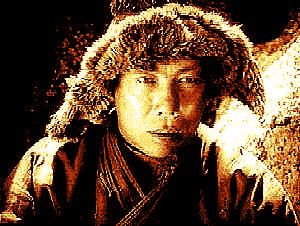Film Review
With
Storm Over Asia, the
great Russian filmmaker Vsevolod Pudovkin completed his ambitious
revolutionary trilogy, following his other two masterworks
Mother (1926) and
The End of St. Petersburg (1927)
with a grand adventure epic to rival anything made by D.W. Griffith,
the director he most admired. This, his last silent film, was the
highpoint of Pudovkin's career. Although he made a number of
films in the sound era, he would rarely live up to his earlier
achievements, and his enthusiasm for filmmaking was greatly diminished
by the need to compromise artistic integrity to the party cause.
Although it is obviously a political film, the sublime artistic qualities of
Storm Over Asia make it
far more than just a piece of revolutionary propaganda.
Pudovkin's brief may have been to make a film celebrating the triumph of
Bolshevism over Imperialism, but this did not prevent him from crafting
one of the greatest of screen epics. Not only does the film tell
a compelling (albeit fictitious) story through some striking
imagery, it also has a documentary purpose, providing a valuable visual
record of Mongol culture and the alluring Mongolian landscape.
Storm Over
Asia should be considered one of the most sophisticated films of
the silent era, prefiguring the lavish adventure epics that Hollywood
would make decades later. Shot entirely on location (the first
film ever to be shot in Mongolia), it has a scale and authenticity that
is rarely found in a film of the 1920s. Yet although the film
contains some stunning photography, which contributes much to its
poetry and realism, its strength lies in Pudovkin's inspired use of
montage.
Along with his compatriot, Sergei Eisenstein, Pudovkin was responsible
for developing the theories of film editing which are now an essential
part of the language of filmmaking. Whilst Eisenstein was
motivated to use these principles of montage to convey political
messages (valuable for propaganda filmmaking), Pudovkin saw how the
same techniques could be used for purely dramatic purposes.
Eisenstein was interested in the abstract concept (such as the heroism
of the Soviet people); Pudovkin's focus was the individual (who would
perhaps personify some noble ideal), a character with whom the audience
could identify.
Pudovkin's mastery of montage is perhaps at its most evident in
Storm Over Asia. Frenetic
cross-cutting between two scenes is used to ratchet up tension and
suspense to an almost unbearable degree - a technique that is to
be found in every action film and every suspense thriller made
today. Repeated cutting between two subjects establishes an
inviolable link between the two subjects in the mind of the spectator -
note how Pudovkin uses this for ironic effect throughout this
film. The juxtaposition of two seemingly unconnected shots works
to create an impression that is contained in neither shot, a technique
that Eistenstein termed
dialectic
montage; again Pudovkin uses this for ironic, rather than
political purposes, to develop character, not convey an abstract idea.
The film's artistic highpoint is reserved for its cataclysmic finale in
which breathtaking camerawork and skilful montage are combined to
deliver one of the cinema's most gripping battle sequences. The
pace of the last five minutes of the film is
breathtaking, the fierce tumult of battle sending a sheer visceral thrill
through the spectator.
If there is one film that shows the immense power of editing, that film
is surely Vsevolod Pudovkin's
Storm
Over Asia, a true landmark in the history of cinema.
© James Travers 2010
The above content is owned by frenchfilms.org and must not be copied.
Film Synopsis
Mongolia, 1918. With his father too ill to sell furs at the
market, Bair, a young herdsman, must take his place. The only
buyers at the market are western traders who pay as little as they can,
knowing that the locals are so poor they will sell at any price.
Disgusted by what he is offered for his furs, Bair attacks the traders
before fleeing into the mountains. Here, he encounters Soviet
partisans who are constantly at war with the occupying British
troops. Two years later, Bair is captured and sentenced to death
by a British general. As the herdsman is being led away, his
captors examine his possessions and find a piece of silk on which is
written an ancient text, which states that whoever owns the silk is the
reincarnation of Genghis Khan. The general sees an opportunity to
bring the local population to heel, by elevating Bair to the position
of a puppet king. Unfortunately, his plan backfires. Bair
becomes a figurehead for the Mongol people, but once he has acquired
this status, he uses his influence to turn on the British and drive
them from his country.
© James Travers
The above content is owned by frenchfilms.org and must not be copied.


